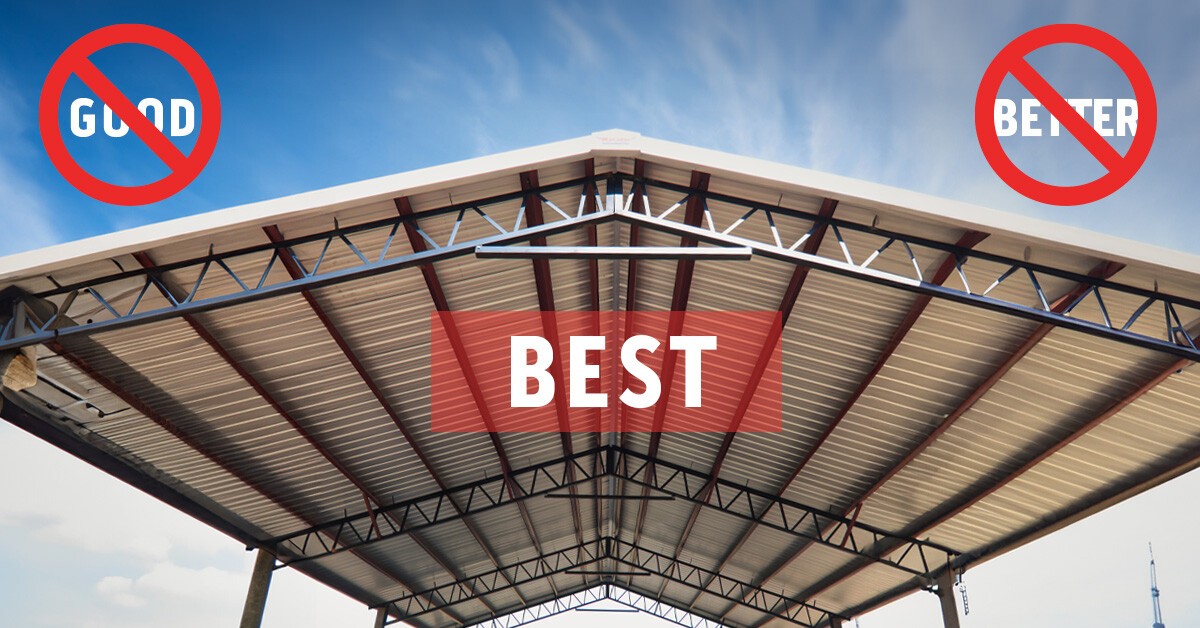Choosing a Pole Barn: Good, Better, and Best Options
August 7, 2024

When it comes to investing in a pole barn, there are a lot of choices. From the materials used to the installation process, each decision impacts your structure's overall quality and longevity. To help you make an informed choice, we've broken down the pole barn options into three categories: Good, Better, and Best. Let's explore what each tier offers and how it fits your needs. We’ll look at the materials, installation, benefits, and other considerations that make up the differences between each choice.
Good: Wood Purlins and Basic Installation
For those on a tight budget, the "Good" option includes wood purlins and basic installation. It’s affordable, but it has limited durability and requires regular maintenance. It's suitable for temporary structures or short-term use.
Pole Barn Materials:
- Wood Purlins: Wood purlins are cost-effective, providing adequate support for most standard metal pole barns. They’re relatively easy to work with and can be locally sourced locally.
- Untreated Lumber: Using untreated lumber will keep initial costs down, but it lacks the durability and resistance to environmental factors that treated lumber offers.
Pole Barn Installation:
- Basic Installation: Installation on a low-end pole barn of this type should be straightforward; you might even be able to do it yourself. However, if you don’t have the right tools and skills, you still might need local contractors. For those on a tight budget or who only need a temporary structure, this could be the way to go.
Benefits:
- Affordability: The most significant advantage of this tier is the cost savings. It’s perfect for those who need a functional pole barn to last for 3-5 years.
- Sense of Accomplishment: There’s a certain reward that comes with doing things yourself. Creating a pole barn could turn carpentry into a new hobby. So, if you want to get a project under your belt and don’t mind that structure won’t last forever, this could be the route for you.
Considerations:
- Durability: Wood purlins and untreated poles will not last as long or be as resilient against the elements as more advanced materials. They will also show wear and tear faster, so if a clean aesthetic is important to you, keep in mind that this structure will start to show its age quickly under the harsh sun and environmental elements.
- Timeline: Undertaking a big DIY project may seem simple, but sometimes, it takes on a life of its own. If you’re doing it yourself, factor the learning curve and potential delays into your timeline.
- Compliance: Ensure you are aware of local building codes and necessary permits. Even for basic installations, compliance with local regulations is essential to avoid fines or other issues.
- Maintenance: Cheaper materials are prone to rot, pests, rust and decay. Regular upkeep will be necessary to keep the structure functional and safe.
Better: Treated Lumber and Enhanced Installation
To get more out of your investment, upgrade to treated lumber and have your pole barn professionally installed. However, those with the know-how may still opt to do it themselves. (A quality pole barn will be sold with full installation guidelines.) This “better” option strikes a balance between cost and durability, making it suitable as a mid-range solution. But for true longevity, there’s still another option.
Pole Barn Materials:
- Wood Purlins with Treated Lumber: Upgrading to pressure-treated lumber can significantly improve the lifespan and durability of your pole barn. Treated lumber is resistant to rot, pests, and environmental damage, making it more robust than untreated lumber.
Pole Barn Installation:
- Enhanced Installation: Professional installation services ensure code compliance and construction quality.
Benefits:
- Improved Durability: Treated lumber resists rot and pests, offering a longer-lasting structure that will withstand environmental factors like sun and rain. A pole barn in this tier could last 5-8 years.
- Professional Craftsmanship: The quality of installation reduces the likelihood of future repairs.
Considerations:
- Cost: With professional installation and higher-end lumber, this option has a higher upfront investment.
- Intermediate Durability: If you’re looking for the longest-lasting pole barn, this isn’t quite it. Wood purlins are good, but they are prone to expansion and contraction, which can affect the integrity of the roof itself. So wood purlins are not as robust as metal, which brings us to the best option in pole barns.
Best: Metal Purlins, Pressure-Treated Poles, and Professional Installation
For those seeking unmatched quality and durability, the "Best" option is the ultimate choice. This tier combines premium materials with professional installation, ensuring your pole barn not only meets but exceeds the highest standards of construction and longevity.
Pole Barn Materials:
- Metal Purlins: Switching to metal purlins offers superior strength and longevity. Metal is resistant to rot, pests, and weather damage, making it an excellent choice for high-performance buildings. Metal purlins also provide better support and stability for the roof, ensuring the structure remains sound over time.
- Pressure-Treated Poles: Continuing with pressure-treated poles ensures the base structure is protected and durable. Treated lumber adds an extra layer of defense against rot and pests, enhancing the pole barn's overall resilience.
Pole Barn Installation:
- Professional Installation: Top-tier installation involves highly skilled professionals who follow best practices and industry standards. The installers will either work for the company that manufactures the pole barn or have a trusted business relationship with them. This type of installation ensures that the barn is built to precise specifications and meets all safety and performance standards. As with the "Better" option, a knowledgeable property owner may still be able to do their own installation, if they have the tools and know-how.
Benefits:
- Maximum Durability: Metal purlins and pressure-treated poles create a structure that can withstand harsh conditions, offering peace of mind for decades. This combination ensures that the pole barn is resistant to environmental stresses, like heavy winds and rain. A pole barn like this will last for decades. (We call our Matador Pole Barns, the last pole barn you'll ever buy - until you want a second one!)
- Minimal Maintenance: Using high-quality materials reduces the need for frequent maintenance, saving time and money in the long run. Metal purlins and pressure-treated poles require less upkeep, making this option more convenient for long-term lifetime use.
- Added Value: A professionally installed, top-quality pole barn can add value to your property. The superior materials and expert installation can enhance the appeal and functionality of your property, making it more attractive to potential buyers.
Considerations:
- Initial Investment: This is the most expensive option, but it's an investment in quality, longevity, and low maintenance. The reduced need for repairs and maintenance, and having fewer worries over the life of the structure justifies a higher upfront cost.
- Project Timeline: While it is usually said that good things come to those who wait, in this case, the best things come (quickly) to those who select a Matador Steel Pole Barn and with their professional installation. Matador Steel pole barns are installed in days, ensuring a high-quality structure without a lengthy construction process.
Choosing the right metal pole barn depends on your specific needs, budget, and long-term plans. While each tier—Good, Better, or Best—offers unique benefits, investing in the Best option ensures unparalleled quality, durability and long-term value. By understanding the differences, you can make an informed decision that maximizes performance and returns on your investment. You can read more about the Benefits of Building a Pole Barn on our blog.











